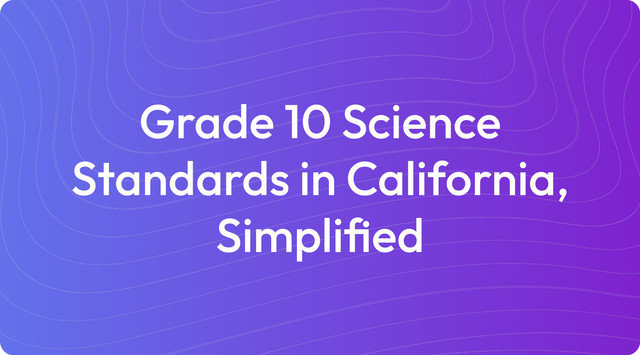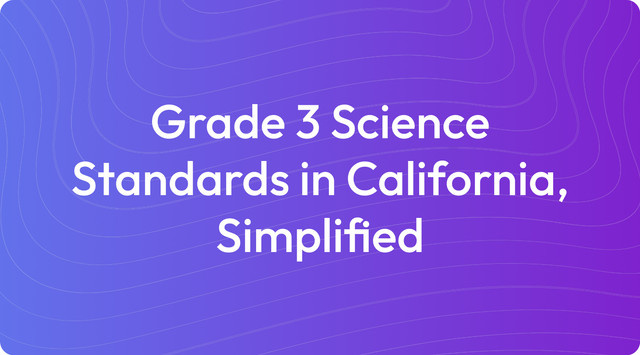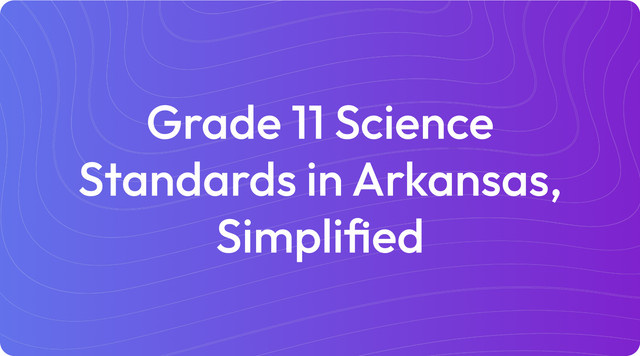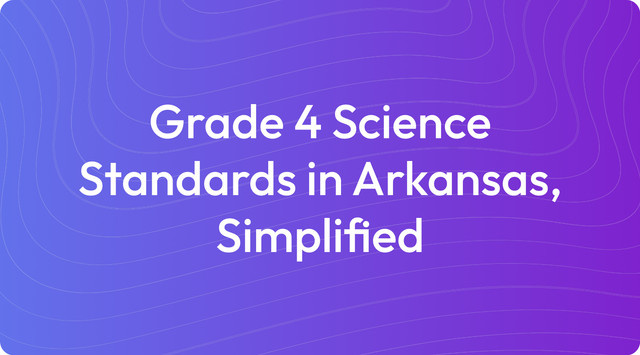Grade 10 Science Standards in Arkansas, Simplified
Grade 10 students in Arkansas study Biology, with options for Environmental Science or advanced electives. Read more now.
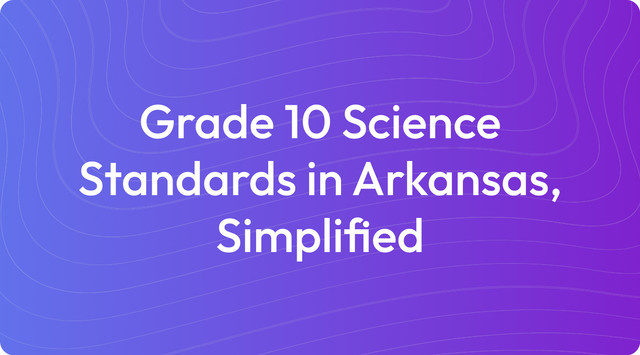
We understand that keeping up with academic standards can feel like a moving target. Our goal is to provide clarity and practical tools to help you focus on what you do best: teaching. We're here to support you with resources that simplify these requirements so you can spend more time with your students.
Education standards are learning goals that outline what students are expected to know by the end of a course or grade level. They provide a framework for what to teach, but you decide how to teach it. For example, Arkansas's 10th-grade science standards require that students in Biology learn about cell structure and ecosystems, but they do not dictate the specific lesson plans or activities you must use to cover those topics.
What Are Grade 10 Science Standards in Arkansas?
In Arkansas, 10th-grade science education is structured around the K-12 Science Standards, which are aligned with the Next Generation Science Standards (NGSS). While Biology is the typical required course for this grade, the standards integrate concepts from several scientific disciplines to provide a comprehensive learning experience.
Here is a breakdown of the key standards and course options for 10th grade:
Grade 10 Science Standards (Integrated Biology)
- Life Science (LS):
- HS-LS1: From Molecules to Organisms: Explores cell structure, organ systems, photosynthesis, and homeostasis.
- HS-LS2: Ecosystems: Interactions, Energy, and Dynamics: Covers energy flow, matter cycling, and population dynamics within ecosystems.
- HS-LS3: Heredity: Inheritance and Variation of Traits: Focuses on DNA, genetic inheritance, mutations, and genetic technology.
- HS-LS4: Biological Evolution: Examines natural selection, adaptation, biodiversity, and the evidence for evolution.
- Earth and Space Science (ESS):
- HS-ESS2: Earth Systems: Studies how ecosystems interact with Earth’s physical systems, like the carbon and water cycles.
- HS-ESS3: Human Impacts: Analyzes how human activity influences ecosystems and natural resources.
- Engineering Design (ETS):
- HS-ETS1: Engineering Design: Involves designing and testing solutions for real-world problems related to biology and the environment.
Science Subjects Available for Grade 10
- Core Option:
- Biology: This course is required for graduation and focuses on the exploration of living systems.
- Elective Options (if Biology is already completed):
- Environmental Science
- Earth and Space Science
- Advanced or Pre-AP Biology
Graduation Requirements
- Students must complete 3 science credits to graduate.
- 1 Credit in Biology (or an equivalent course)
- 1 Credit in a Physical Science (such as Physical Science, Chemistry, or Physics)
- 1 Additional Science Credit from a list of approved courses
Additional Science Options
Depending on the school, students may have access to other science courses, including:
- Forensic Science
- Anatomy and Physiology
- Marine Biology
- Agricultural Science
- AP Biology
The framework for these standards is guided by the Next Generation Science Standards and implemented at the state level by the Arkansas Division of Elementary and Secondary Education. These guidelines help ensure students are prepared for future academic and career paths.
Key Tested Standards
For Grade 10 Science in Arkansas, assessments are primarily based on Biology, the core course for this grade level. The standards test foundational life science concepts that are essential for both state assessments and future science studies. Here are the key areas you can expect to see on tests:
Key Tested Standards in Grade 10 Biology
Life Science (LS)
The Life Science standards cover four main areas:
- HS-LS1: From Molecules to Organisms: This unit focuses on the building blocks of life. Students are expected to:
- Explain how DNA and cellular activities direct the functions of an organism.
- Use models to show how photosynthesis transforms light energy into chemical energy.
- Model the flow of matter and energy in cellular respiration.
- HS-LS2: Ecosystems: Interactions, Energy, and Dynamics: This unit explores the relationships within ecosystems. Students will need to:
- Analyze evidence to see how the availability of resources impacts populations.
- Create models that illustrate the cycling of matter and flow of energy.
- Evaluate claims about how ecosystem changes affect populations and biodiversity.
- HS-LS3: Heredity: Inheritance and Variation of Traits: This unit covers genetics. Key skills include:
- Modeling how DNA and chromosomes pass genetic traits from parents to offspring.
- Explaining the effects of genetic mutations on proteins and traits.
- HS-LS4: Biological Evolution: Unity and Diversity: This unit examines the principles of evolution. Students should be able to:
- Analyze fossil and DNA evidence that supports the theory of evolution.
- Construct an explanation for how natural selection results in population adaptations.
Earth and Space Science (ESS) Standards in Biology
Biology also integrates key Earth science concepts, especially in environmental contexts:
- HS-ESS2-6: Explaining the interaction between Earth’s systems, like the water and carbon cycles, and ecosystems.
- HS-ESS3-4: Evaluating potential solutions for lessening the impact of human activities on biodiversity.
Common Themes Across Standards
Across these standards, several key scientific practices are emphasized:
- Modeling: Creating and using models to explain processes like photosynthesis, cellular respiration, and heredity
- Data Analysis: Interpreting graphs, population data, and evidence for evolution
- Constructing Explanations: Writing evidence-based explanations for phenomena such as natural selection or ecosystem changes
The information on these standards is compiled from guidelines provided by the Next Generation Science Standards and the Arkansas Division of Elementary and Secondary Education.
Source: Next Generation Science Standards
Source: Arkansas Division of Elementary and Secondary Education
Example Learning Objectives for Unit Planning
Learning objectives are clear, specific statements that describe what you want your students to know or be able to do by the end of a lesson. They help focus your instruction and make learning goals transparent for students. These objectives are aligned with the NGSS-based standards and written in student-friendly language.
Here are examples of learning objectives for Grade 10 science standards in Arkansas, focusing on Biology:
Standard: HS-LS1-5
Use a model to illustrate how photosynthesis transforms light energy into stored chemical energy.
Learning Objectives:
- I can explain the role of sunlight, carbon dioxide, and water in photosynthesis.
- I can use a diagram to show how plants produce glucose and oxygen.
- I can describe how photosynthesis provides energy for ecosystems.
Standard: HS-LS1-7
Use a model to show how matter and energy cycle during cellular respiration.
Learning Objectives:
- I can explain how glucose and oxygen are used to produce energy in cells.
- I can model the inputs and outputs of cellular respiration (e.g., glucose, oxygen, carbon dioxide).
- I can compare how photosynthesis and cellular respiration work together in living organisms.
Standard: HS-LS2-3
Develop a model to show how matter cycles and energy flows through ecosystems.
Learning Objectives:
- I can explain how energy moves through a food chain or food web.
- I can use a model (e.g., energy pyramid) to demonstrate energy transfer between trophic levels.
- I can describe how decomposers recycle matter back into the ecosystem.
Standard: HS-LS3-1
Model the role of DNA in genetic inheritance.
Learning Objectives:
- I can describe how DNA carries genetic information.
- I can explain how genes are passed from parents to offspring.
- I can use a Punnett square to predict the probability of inheriting traits.
Standard: HS-LS4-1
Analyze evidence from fossils and DNA to support evolution.
Learning Objectives:
- I can explain how fossils provide evidence for changes in species over time.
- I can analyze similarities in DNA to show relationships between species.
- I can identify patterns that demonstrate how organisms evolve through natural selection.
Key Changes & Updates
The Grade 10 Science Standards in Arkansas, which focus on Biology, were updated in 2015 to align with the Next Generation Science Standards (NGSS). This shift was designed to help you move instruction away from simple memorization and toward a more dynamic, three-dimensional learning model. This approach integrates science practices (like investigating and modeling), crosscutting concepts (like cause and effect), and core disciplinary ideas. The goal is to ground your lessons in real-world phenomena and inquiry, encouraging students to ask questions like, “How are traits inherited across generations?”
The updated standards also change how student understanding is assessed, emphasizing performance-based tasks. Instead of just recalling facts, students are asked to analyze data, construct evidence-based arguments, and apply engineering design principles to biological problems. For example, a student might design a solution to reduce human impact on an ecosystem. This focus on systems thinking and argumentation helps develop the critical skills needed for future STEM learning and careers, making science more relevant and engaging for your students.
Create with TeachShare
We understand that translating these standards into engaging, day-to-day lessons is a significant task. Our goal is to support your expertise by providing tools that make creating high-quality, inquiry-based materials simpler and faster. This way, you can spend less time on paperwork and more time fostering a love of science in your classroom. Start creating standards-aligned instructional resources with TeachShare now.
Frequently Asked Questions
1. What topics are covered in Grade 10 Biology?
In Arkansas, the Grade 10 Biology course, which aligns with the state's science standards, typically focuses on these core areas:
- Cellular functions like photosynthesis and respiration
- Genetics, including DNA, inheritance, and variation
- Ecosystem dynamics, such as energy flow and populations
- Evolutionary concepts like natural selection and biodiversity
- The effects of human activities on the environment
2. What is the goal of the updated science standards?
The main goal is to shift learning from simple memorization to active inquiry. The standards encourage a three-dimensional approach that helps students think and act like scientists by:
- Engaging in hands-on investigations and engineering practices.
- Connecting big ideas that apply across all scientific fields.
- Building a solid foundation of core knowledge in biology.
3. How can I connect Grade 10 Biology to the real world?
You can help students see the relevance of biology by connecting lessons to tangible examples. Here are a few ideas:
- Genetics: Discussing genetic technologies or the basis of hereditary diseases
- Ecosystems: Analyzing the local effects of climate change or deforestation
- Cellular Processes: Explaining how photosynthesis relates to food production
- Evolution: Using DNA evidence to trace how different species have adapted
4. How do these standards prepare students for their future?
These standards build a strong foundation for what comes next, whether it's another science class or a future career. Students develop essential skills in data analysis, modeling, and forming arguments from evidence. This prepares them for advanced courses like AP Biology or Chemistry and fosters the critical thinking needed for many professions.
5. What are some ways to make these standards more engaging?
Bringing the standards to life is key to student success. Here are some strategies teachers have found effective:
- Start lessons with a compelling real-world question, like “Why are local bee populations declining?”
- Incorporate hands-on labs and activities that let students experiment directly.
- Use technology, such as virtual labs or simulations, to visualize complex processes.
- Encourage group projects that challenge students to solve problems together.
Answer



